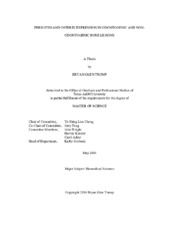| dc.description.abstract | Osterix is a transcription factor that is essential for osteoblast differentiation and
periostin is a matricellular protein that, in the jaw bones, is expressed in the periosteum
and periodontal ligament (PDL). It has been hypothesized that the co-expression of
osterix and periostin supports a histogenesis of PDL origin. The purpose of this study
was to investigate the expression patterns of periostin and osterix in some jawbone
lesions and correlate the results with current concepts regarding the cell of origin of
these bone diseases. We also wanted to test whether or not the co-expression of
periostin and osterix are indeed PDL- specific. We investigated the expression patterns
of periostin and osterix, using immunohistochemistry, in cases of cemento-osseous
dysplasia (COD), ossifying fibroma of the jawbones (OFJ), osteoblastoma of the
jawbones (OBJ), odontogenic myxoma (OM), osteosarcoma of the jawbones (OSJ),
osteosarcoma of the long bones (OSL) and osteoblastoma of the long bones (OBL). All
bone lesions (n=57) selected for this study stained positive for periostin. For osterix
expression, COD, OSJ, OBL, and most cases of OFJ, OM and OBJ showed positive
results. OSL, except for the anaplastic/fibroblastic histological variant, also showed
osterix expression. As there is no PDL in the long bones, these results demonstrated that
the co-expression of these two proteins was not PDL-specific. The co-expression of
osterix and periostin in OM lesional cells suggest a potential differentiation for
osteogenesis or PDL origin, despite no calcified material is found in this neoplasm. We
also report a novel finding that osterix-positive cells and periostin expression were found
in the lamina propria, and osterix-positive cells were also found in squamous epithelium of normal gingival mucosa. | en |


